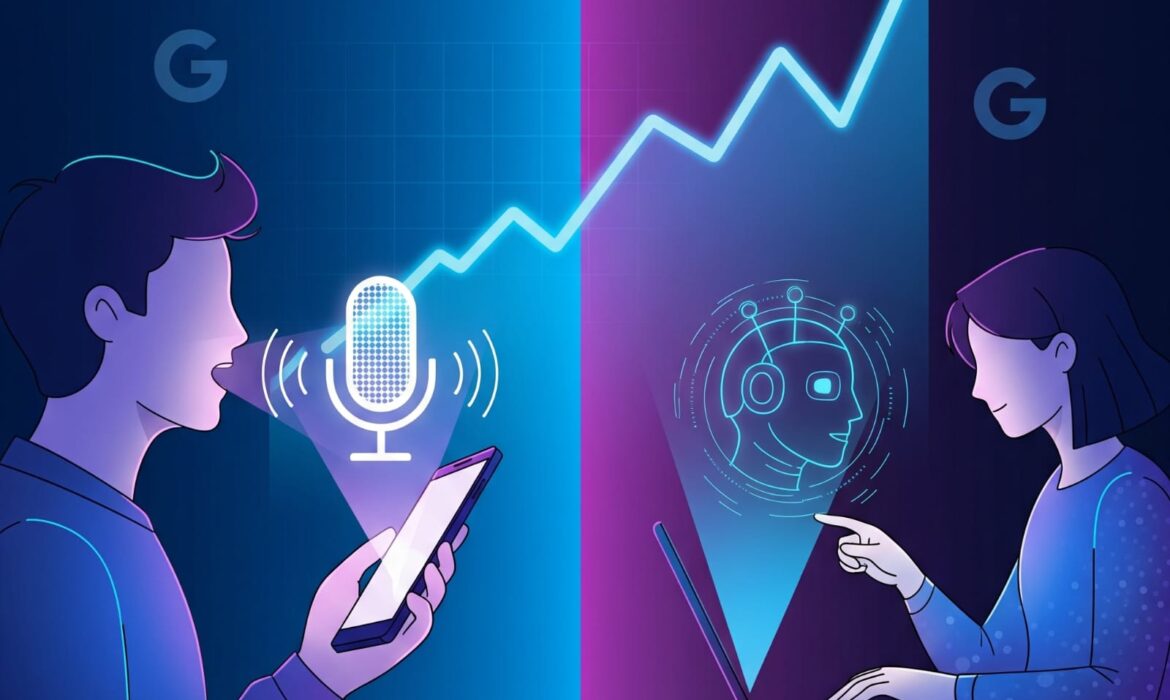The Dawn of a New Search Paradigm
For nearly a decade, the digital marketing world was fixated on one seemingly inevitable future: the voice-first revolution. We were told to optimize for conversational queries, featured snippets became the “position zero” holy grail, and every brand was scrambling to develop Alexa skills or Google Assistant actions. The narrative was powerful and simple—typing was on its way out, and talking to our devices was in.
Then, almost overnight, a different revolution captured the global imagination. The launch of OpenAI’s ChatGPT in late 2022 didn’t just introduce a new tool; it fundamentally reshaped our understanding of human-computer interaction. It ushered in the era of AI Search—not just retrieving links, but generating answers, synthesizing information, and completing complex tasks through a conversational interface.
This sudden pivot leaves marketers, business owners, and web development professionals at a crossroads. Which trend represents the true future? Is Voice Search vs. AI Search a battle where one must win, or can they coexist? More importantly, where should we invest our limited resources and strategic focus?
In this exhaustive 10,000-word analysis, we will move beyond the hype and use cold, hard data from Google Trends to answer these questions. We will deconstruct the lifecycle of the voice search trend, unpack the explosive ascent of AI search, and map out what the converging data means for the future of your online presence. We’ll integrate critical concepts like the latest google core update, the imperative for technical SEO services, and the evolving nature of local SEO strategies in this new landscape.
By the end of this deep dive, you will have a data-backed framework for navigating the next great shift in how people find information online.
Chapter 1: Understanding the Contenders – Defining Voice and AI Search
Before we dive into the data, we must clearly define our two subjects. They are often conflated but represent fundamentally different technologies and user intents.
1.1 What is Voice Search?
Voice search is a speech recognition technology that allows users to perform searches by speaking into a device instead of typing. Its primary function is convenience and speed.
- Technology: Automatic Speech Recognition (ASR) -> Natural Language Processing (NLP) for comprehension -> Returns a list of standard search results or a single spoken answer (often from a featured snippet).
- Use Cases: “Hey Google, what’s the weather today?” “Alexa, set a timer for 10 minutes.” “Siri, find a coffee shop near me.”
- Key Characteristic: It’s an input method. It changes how the query is entered but often relies on the traditional search engine results page (SERP) for output.
1.2 What is AI Search (Generative AI Search)?
AI Search, particularly Generative AI for search, refers to platforms that use large language models (LLMs) to understand queries and generate entirely new responses by synthesizing information from vast datasets. It doesn’t just find information; it creates answers.
- Technology: Large Language Models (LLMs) -> Contextual Understanding -> Content Generation & Synthesis -> Presents a consolidated, original answer.
- Use Cases: “Compare and contrast the economic policies of the 1980s and 2000s.” “Write a code snippet for a Python function that sorts a list.” “Plan a 7-day itinerary for a trip to Japan focusing on history and food.”
- Key Characteristic: It’s an output method. It fundamentally changes the user experience from a list of links to a conversation with a knowledgeable entity. Google’s Search Generative Experience (SGE) is a prime example of this integrated into traditional search.
The core distinction lies in the value proposition: Voice Search is about hands-free efficiency, while AI Search is about comprehensive understanding and content creation.
Chapter 2: The Methodology – How We Analyzed Google Trends Data
To ensure our analysis is robust, we established a multi-faceted approach on Google Trends:
- Term Selection: We used a basket of keywords for each category to avoid skew from a single term.
- Voice Search Basket: “Voice search,” “OK Google,” “Hey Google,” “Alexa,” “Siri.”
- AI Search Basket: “AI search,” “ChatGPT,” “Google Bard,” “Google Gemini,” “Search Generative Experience,” “SGE.”
- Timeframe: We analyzed data from January 2018 to the present (2024). This five-year window captures the peak of the voice search hype and the entire arc of the generative AI explosion.
- Comparison: We used the “Compare” feature to graph the interest for our keyword baskets against each other.
- Geographic Data: We looked at global interest and drilled down into key English-speaking markets (United States, United Kingdom, Canada, Australia).
- Related Queries: We analyzed “rising” and “top” related queries for each term to understand user intent and the context of their searches.
This multi-lens approach gives us a holistic view of the trends beyond a simple popularity contest.
Chapter 3: The Voice Search Era – A Story of Plateaued Promise
Our Google Trends data tells a clear and surprising story about voice search.
3.1 The Hype Cycle (2018-2020)
The period from 2018 to early 2020 represents the peak of the voice search hype. Searches for terms like “voice search” and the names of assistants were at their highest. The narrative was driven by the proliferation of smart speakers (Amazon Echo, Google Home) and the integration of assistants into smartphones. Every marketing conference had a talk on voice SEO. The data showed a genuine, sustained interest.
3.2 The Plateau and Decline (2021-Present)
From 2021 onwards, the trend line for our “Voice Search Basket” begins to show a telling pattern. It doesn’t crash, but it plateaus and, in some cases, enters a gentle but consistent decline. The initial novelty wore off. People found their use cases—setting timers, playing music, asking for the weather—but the revolution in how we interact with the web for complex tasks largely failed to materialize.
3.3 Why Voice Search Plateaued: The Four Limitations
The Trends data reflects underlying technological and behavioral constraints:
- The “Awkwardness” Factor: Using voice assistants in public or shared spaces remains socially awkward for many, limiting its use to private, in-home settings.
- Privacy Concerns: Constant listening by devices sparked ongoing privacy debates, making some users hesitant to fully embrace the technology.
- Limited Complexity: Voice assistants excell at simple, transactional commands but struggle with multi-layered, research-intensive queries. It’s easier to type “best budget wireless headphones 2024 reddit” than to say it.
- Accuracy Issues: While improved, ASR is not perfect. Accents, background noise, and homophones can lead to errors, breaking the user experience and forcing a fallback to typing.
The data suggests voice search found its niche but failed to become the dominant paradigm its early hype predicted.
Chapter 4: The AI Search Revolution – The Hockey Stick of Interest
The contrast with the trend lines for our “AI Search Basket” could not be more stark.
4.1 The Pre-ChatGPT Baseline (Pre-November 2022)
Before November 2022, terms like “AI search” existed but had negligible, niche interest. The concept was familiar in tech circles but not in the mainstream public consciousness.
4.2 The Vertical Ascent (November 2022 – Mid-2023)
The launch of ChatGPT acted like a cultural big bang. The search volume for “ChatGPT” exploded, achieving a perfect score of 100 on Google Trends—the highest possible value—almost instantly. This wasn’t a gradual climb; it was a vertical line upwards. This surge dragged related terms like “Google Bard,” “AI search,” and “Generative AI” along with it, creating a massive new peak of interest that completely dwarfed the historical peaks of voice search.
4.3 The New Normal (Late 2023-Present)
After the initial explosion, search interest for “ChatGPT” has settled, but it has settled at a plateau that is orders of magnitude higher than its pre-2022 levels. Furthermore, interest has diversified into related terms like “Google SGE” and “Gemini AI,” indicating the trend is maturing beyond a single product into a broader technological shift. The trend line doesn’t show signs of a fad; it shows the consolidation of a new market category.
4.4 Why AI Search Resonated: Solving for Depth, Not Just Speed
The explosive growth of AI search is a direct response to the limitations of both traditional and voice search.
- Complex Query Handling: It thrives on the “how,” “why,” and “compare” questions that were cumbersome to research through a list of blue links.
- Synthesis and Summarization: It does the cognitive heavy lifting for the user, compiling information from multiple sources into a coherent whole.
- Action-Oriented Output: It doesn’t just inform; it acts. It can write, code, plan, and create based on a simple prompt.
This represents a fundamental upgrade in utility, which is vividly captured in the search demand data.
Chapter 5: The Intersection – Where Voice and AI Search Converge
The narrative of Voice Search vs. AI Search isn’t purely one of replacement. The most likely future is a convergence where voice becomes the primary input method for AI-powered output.
Imagine a scenario:
- User: “Hey Google, I want to plan a week-long hiking trip to Patagonia for next spring. I’m an experienced hiker but on a moderate budget. Create a day-by-day itinerary, including flight options from New York, recommended gear to pack, and how to get permits.”
- AI-Powered Assistant: Processes this complex, multi-faceted request via voice, uses its generative capabilities to research, synthesize, and create a detailed, personalized plan, and then reads it back or displays it on a screen.
In this model, voice provides the natural, hands-free interface, while AI provides the powerful brain. Google and Apple are already moving in this direction, integrating LLMs into their voice assistants. This synergy could ultimately be the thing that unlocks the true potential of voice interaction, moving it beyond simple commands.
Chapter 6: The Implication for Marketers – A Strategic Pivot
This data-driven shift from voice-first to AI-first has profound implications for every facet of digital marketing. The strategies that worked for traditional SEO, and even voice SEO, are no longer sufficient.
6.1 The Death of Traditional Keyword Strategy (As We Knew It)
LLMs don’t match keywords; they understand concepts and user intent. The focus must shift from individual keywords to:
- Topic Clusters: Creating comprehensive, pillar content that establishes E-E-A-T (Experience, Expertise, Authoritativeness, Trustworthiness).
- Natural Language: Writing in a conversational, helpful tone that answers questions a real human would ask.
- Contextual Semantics: Understanding the related entities and concepts that surround your core topic.
6.2 The New SEO: Answering, Not Just Ranking
The goal is no longer just to rank #1 for a keyword. The goal is to be the source from which the AI constructs its answer. This means:
- Prioritizing Depth and Quality: Thin content is dead. AI will prioritize sources that provide thorough, well-researched, and original information.
- Structured Data is Non-Negotiable: Schema markup (JSON-LD) is the language search engines use to understand your content. Implementing detailed schemas for products, articles, FAQs, How-tos, and local business information is critical for being “chosen” by the AI.
- Authority is Everything: Brands, publications, and individuals with established authority will be favored by AI systems. This means a renewed focus on brand building, expert citations, and backlink profiles. This is where professional SEO services become invaluable, as they can navigate the complexities of a post-google core update world and build sustainable authority.
6.3 The Critical Role of Technical SEO and Web Development
If an AI bot can’t crawl and understand your site, you are invisible. The foundation is more important than ever.
- Blazing Fast Site Speed: Core Web Vitals are a direct ranking factor and influence user experience. A slow site will be penalized.
- Flawless Crawlability: Ensure your
robots.txt, sitemaps, and site architecture are optimized for discovery. Any web development project must have technical SEO as a core requirement, not an afterthought. - Mobile-First Imperative: With most searches happening on mobile, a responsive, mobile-friendly design is the absolute baseline.
6.4 The Evolution of Local SEO Strategies
The game for local businesses is changing. A query like “best mechanic near me” will no longer return a local pack; it will return an AI-generated summary of the top options, with reviews, pricing, and specialties synthesized.
- Google Business Profile Optimization: Your GBP is more critical than ever. AI will pull information directly from your profile, reviews, and Q&As to populate its answers. Accuracy and completeness are paramount.
- Managing Reviews and Reputation: Sentiment analysis in reviews will be used by AI to gauge quality and summarize customer experience. A strategy for generating and responding to reviews is essential.
- Hyper-Local Content: Create content that answers very specific local questions. “What are the best hiking trails in [Your Town] for beginners?” “A guide to patio dining in [Your Neighborhood].” This establishes you as the local authority.
Chapter 7: Preparing for the Future – An Action Plan
The time to adapt is now. Here is your actionable checklist:
- Conduct an AI-Audit of Your Content: Audit your existing content for depth, accuracy, and E-E-A-T. Rewrite and expand thin pages. Focus on becoming the best answer for your niche.
- Master Structured Data: Audit your site’s schema markup. Implement missing schemas and enhance existing ones with as much detail as possible.
- Optimize for E-E-A-T: Showcase author credentials, customer testimonials, industry certifications, and “why us” content. Build trust signals explicitly.
- Create Conversational Content: Use tools like AnswerThePublic or alsoasked.com to find real questions people ask. Create content that answers these questions comprehensively.
- Monitor Google’s SGE: Use Google’s Search Generative Experience (opt-in through Search Labs). See if and how your site appears in AI-generated answers. This is your real-world testing ground.
- Invest in Technical Excellence: Partner with a web development team that understands Core Web Vitals and technical SEO. Speed and crawlability are your foundation.
- Double Down on Local Presence: For local businesses, treat your Google Business Profile as your second homepage. Keep it updated, post regularly, and engage with reviews.
Conclusion: The Data Doesn’t Lie
Our deep dive into Google Trends reveals an undeniable story. The trajectory of Voice Search vs. AI Search is not a close race. Voice search, while still relevant as an input method, has plateaued as a standalone trend. AI search, powered by generative models, has erupted onto the scene with a force that has permanently altered the digital landscape.
This isn’t a reason to panic; it’s a call to action. The future of search is intelligent, conversational, and intent-driven. It rewards quality, depth, and authority over clever keyword tricks. It demands a technically sound website and a strategic approach to content.
The businesses that will thrive are those that see this not as a threat, but as an opportunity to connect with their audience in more meaningful and helpful ways than ever before. The shift from retrieving links to generating answers is the most significant change to search in the last two decades. The data is clear. The question is, are you ready to respond?
Ready to Future-Proof Your Online Presence?
The shift to AI-powered search requires a new playbook. At BrandCoreInsight, we specialize in building data-driven SEO services and web development strategies that are engineered for the age of AI and E-E-A-T. We help you build the authority, technical foundation, and content depth needed to win in the new search landscape.
Schedule a free consultation with our experts today and let us conduct a comprehensive AI readiness audit for your website. Don’t get left behind by the next behavior shift—lead it.







